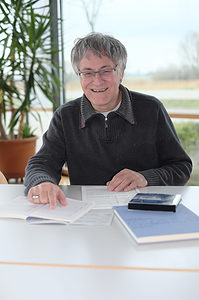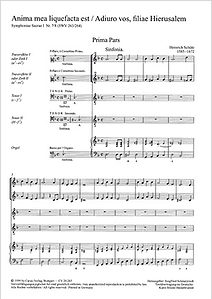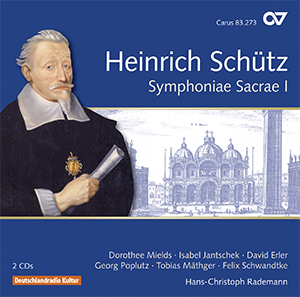See with your ears and listen with your eyes
Every month a member of the Carus team introduces his/her favorite work, whether it be a choral piece, a CD, a songbook or an instrumental work. The recommendation for April 2019 was contributed by Uwe Wolf.
What superb music! You think you will hardly be able to bear the tension! Ever since I heard these two companion pieces for 2 tenors, two cornetts, and continuo over 30 years ago (on an LP record!), they have fascinated me as few other compositions amongst Heinrich Schütz’s amazing output. Since then I have heard them countless times in a huge variety of recordings, and have even taken part in performances myself a few times. And this music still gets right under my skin! In particular, the end of the second part packs quite a punch. After a recitative section which concludes with a fermata, there are two tutti measures at the word “quia” (“because”), which almost seem to open a door: this suddenly feels like music scored for large forces, yet there are still only four parts plus basso continuo. After a further fermata, the music at the words “quia amore langueo” (“because I languish for love”) turns into an imitative song of lamenting, liberally sprinkled with dissonances. Yet despite the suspensions which dovetail into each other, nothing sounds “false”, but the tension produced is almost impossible to listen to.
Schütz had been living in Venice for just under a year when he had this pair of works published in the Symphoniae sacrae I in September 1629. An earlier version of the composition, scored for similar forces, survives in manuscripts. Some things from the early form of the work can be recognized in the printed version, yet worlds lie between the two versions. The dissonant final section (and the highly effective fermatas) are also missing. Here we notice quite directly something of Schütz’s encounter with new Venetian music, which had “greatly changed … and markedly improved” following his first Venice trip – and in which Claudio Monteverdi now set the tone.
As a musicologist, Dr. Uwe Wolf is particularly at home in the 17th and 18th centuries. The focus of his work ranges from the time of Monteverdi and Schütz to Bach and the generation of Bach’s sons and pupils through to Viennese Classicism. He has been head of the editorial department at Carus-Verlag since October 2011. Prior to this, he worked in Bach research for over 20 years.







Leave a Reply
Want to join the discussion?Feel free to contribute!